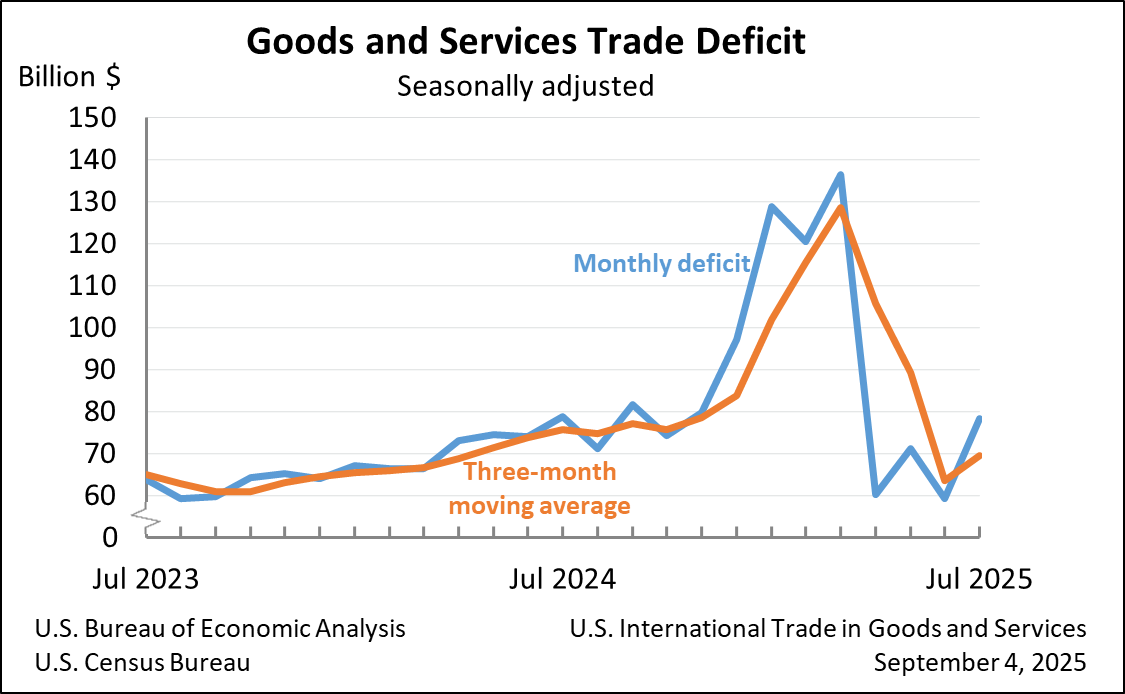Bureau of Economic Analysis
U.S. International Trade in Goods and Services, July 2025
The U.S. goods and services trade deficit increased in July 2025 according to the U.S. Bureau of Economic Analysis and the U.S. Census Bureau. The deficit increased from $59.1 billion in June (revised) to $78.3 billion in July, as imports increased more than exports. The goods deficit increased $18.2 billion in July to $103.9 billion. The services surplus decreased $1.1 billion in July to $25.6 billion.
Principal Federal Economic Indicators
Noteworthy
The Latest
March 2023 Trade Gap is $64.2 Billion
The U.S. goods and services trade deficit decreased from $70.6 billion in February (revised) to $64.2 billion in March, as exports increased and imports decreased. The goods deficit decreased $6.4 billion to $86.6 billion, and the services surplus decreased less than $0.1 billion to $22.4 billion.
U.S. International Trade in Goods and Services, March 2023
The U.S. monthly international trade deficit decreased in March 2023 according to the U.S. Bureau of Economic Analysis and the U.S. Census Bureau. The deficit decreased from $70.6 billion in February (revised) to $64.2 billion in March as exports increased and imports decreased. The goods deficit decreased $6.4 billion in March to $86.6 billion. The services surplus decreased less than $0.1 billion in March to $22.4 billion.
Patricia Abaroa Named New BEA Deputy Director
Patricia Abaroa is the new Deputy Director of the Bureau of Economic Analysis, bringing decades of economic accounting experience to the post.
Personal Income and Outlays, March 2023
Personal income increased $67.9 billion, or 0.3 percent at a monthly rate, while consumer spending increased $8.2 billion, or less than 0.1 percent, in March. The personal saving rate (that is, personal saving as a percentage of disposable personal income) was 5.1 percent in March, compared with 4.8 percent in February.
Personal Income and Outlays, March 2023
Personal income increased $67.9 billion, or 0.3 percent at a monthly rate, while consumer spending increased $8.2 billion, or less than 0.1 percent, in March. The personal saving rate (that is, personal saving as a percentage of disposable personal income) was 5.1 percent in March, compared with 4.8 percent in February.
Gross Domestic Product, First Quarter 2023 (Advance Estimate)
Real gross domestic product (GDP) increased at an annual rate of 1.1 percent in the first quarter of 2023, according to the "advance" estimate. In the fourth quarter of 2022, real GDP increased 2.6 percent. The increase in the first quarter primarily reflected an increase in consumer spending that was partly offset by a decrease in inventory investment.
Gross Domestic Product, First Quarter 2023 (Advance)
Real gross domestic product increased at an annual rate of 1.1 percent in the first quarter of 2023, according to the “advance” estimate. In the fourth quarter of 2022, real GDP increased 2.6 percent. The increase in the first quarter primarily reflected an increase in consumer spending that was partly offset by a decrease in inventory investment.
U.S. International Trade in Goods and Services, February 2023
The U.S. monthly international trade deficit increased in February 2023 according to the U.S. Bureau of Economic Analysis and the U.S. Census Bureau. The deficit increased from $68.7 billion in January (revised) to $70.5 billion in February, as exports decreased more than imports. The goods deficit increased $2.7 billion in February to $93.0 billion. The services surplus increased $0.8 billion in February to $22.4 billion.
February 2023 Trade Gap is $70.5 Billion
The U.S. goods and services trade deficit increased from $68.7 billion in January (revised) to $70.5 billion in February, as exports decreased more than imports. The goods deficit increased $2.7 billion to $93.0 billion, and the services surplus increased $0.8 billion to $22.4 billion.
Gross Domestic Product by State and Personal Income by State, Year 2022
Real gross domestic product (GDP) increased in 42 states and the District of Columbia in 2022, with the percent change in real GDP ranging from 4.9 percent in Idaho to –2.4 percent in Alaska.




